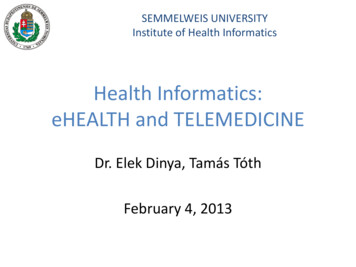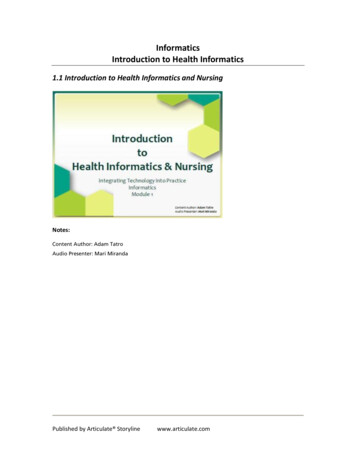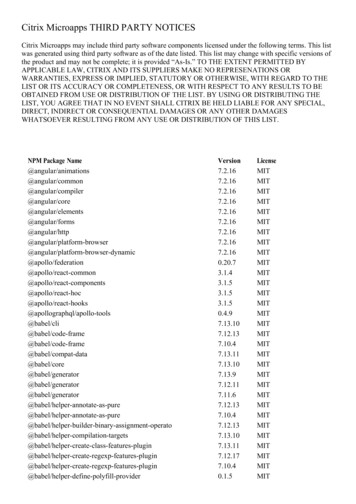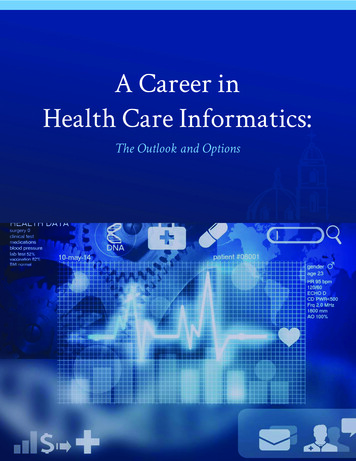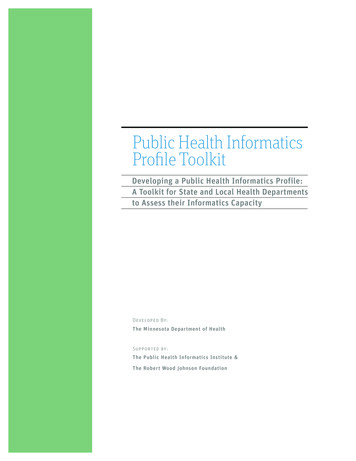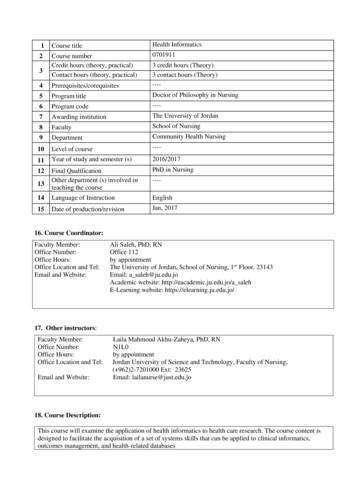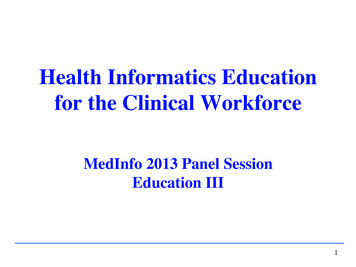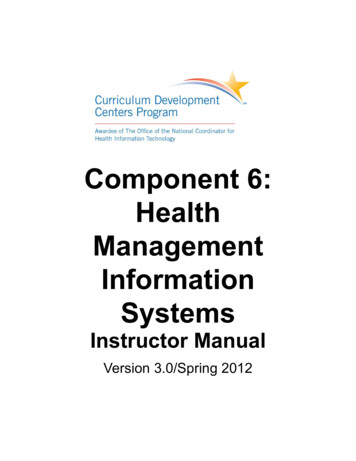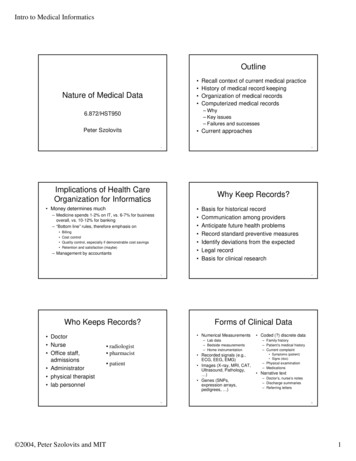
Transcription
Intro to Medical InformaticsOutline Nature of Medical DataRecall context of current medical practiceHistory of medical record keepingOrganization of medical recordsComputerized medical records– Why– Key issues– Failures and successes6.872/HST950Peter Szolovits Current approaches12Implications of Health CareOrganization for InformaticsWhy Keep Records? Money determines much – Medicine spends 1-2% on IT, vs. 6-7% for businessoverall, vs. 10-12% for banking– “Bottom line” rules, therefore emphasis on BillingCost controlQuality control, especially if demonstrable cost savingsRetention and satisfaction (maybe)– Management by accountantsBasis for historical recordCommunication among providersAnticipate future health problemsRecord standard preventive measuresIdentify deviations from the expectedLegal recordBasis for clinical research3Who Keeps Records? Doctor Nurse Office staff,admissions Administrator physical therapist lab personnel4Forms of Clinical Data Numerical Measurements radiologist pharmacist patient5 2004, Peter Szolovits and MIT Coded (?) discrete data– Lab data– Bedside measurements– Home instrumentation– Family history– Patient’s medical history– Current complaint Recorded signals (e.g.,ECG, EEG, EMG) Images (X-ray, MRI, CAT,Ultrasound, Pathology, ) Genes (SNPs,expression arrays,pedigrees, ) Symptoms (patient) Signs (doc)– Physical examination– Medications Narrative text– Doctor’s, nurse’s notes– Discharge summaries– Referring letters61
Intro to Medical InformaticsOrganization of DataPOMR Doctor’s journal (traditional) Time order of collection, per patient(Mayo) Source of data Problem-Oriented Medical Record(POMR) (L. Weed, 1969)– Notes organized by problems– SOAP: subjective, objective, assessment,plans7–––––Social historyRisk factorsSymptomsPhysical findingsLab testsduodenal ulcer appears under the ulcer9Example Problem ListDate1 Hypertension19532 Recurrent bronchitis19583 Penicillin allergy19584Inactive10Problem-Related Plans Diagnostic: lab tests, radiology studies,consultations, continued observations, Therapeutic: medications, diet,psychotherapy, surgery, Patient education: instruction in self-care,about goals of therapy, prognosis, DateS/P pyelonephritis 19607 PleurisyOct 1972 ÆCholecystectom Mary1973Mar 1973 Æ#9June1973Mar 1973 Æ#9June8 ProteinuriaApr 1973 Æ#99 SLEJune1973Nov10 Unemployment8 Causally organized; e.g., GI bleeding caused by Physical examination Laboratory data and physiologic tests (complete blood count,electrocardiogram, chest x-ray, creatinine, urinalysis, vital capacity,tonometry, etc.)6 ArthralgiasProgress Notes(by problem) “those features in the patient’s psychobiologicalmakeup that require continuing attention”Chief complaintsHistory of present illnessPast medical historyReview of systemsFamily historyMedications5 GallstonesPlans(by problem)The Problem List Identifying information (name, age, sex, race, religion, insurance info,etc.) Patient profile (occupation, education, marital status, children,hobbies, worries, moods, sleep patterns, habits, etc.) Medical historyNo ActiveProblem Listdiagnostic, therapeutic,patient educationThe Data Base––––––Data Base1973June1973197311 2004, Peter Szolovits and MIT122
Intro to Medical InformaticsPlans per problemPlans per problem (cont.)1. Diarrhea2. PyuriaDx: Dx:stool for occult blood, culture, ova, and parasites,microscopic fat; and muscle fibersSigmoidoscopyBarium enema if persistent Rx: Avoid foods that exacerbateEd: Informed that more info is needed to make adiagnosis, will aim for symptomatic therapy for now.BUNRepeat urinalysisUrine culture3. ObesityRx:Ed:1500 kcal diet, Weight WatchersDangers of obesity cited. Goal: 170 lbs.1314Progress NotesExample SOAP Note Subjective: interval history, adherence toprogram Objective: physical findings, reports of lab,x-ray, other tests Assessment: Appraisal of progress,interpretation of new findings, etc. Plan: Dx, Rx, Ed.#3 RHD with mitral stenosisS: 2 flight dyspnea, mild fatigue. No orthopnea, hemoptysis, ankleedema. Child has strep throat.O: BP 120/70. P 78 regularNeck veins normal, lungs clear.Grade iii diastolic rumble, wide opening snap, P2 slightly A: Stable. Catheterization still not indicated. Risk of strep throatpresent.P: Dx: Cardiac fluoroscopyRx: Continue chlorothiazide and penicillin V 250mg b.i.d.—2weeksEd: Reinstructed about antibiotic coverage for toothextractions,sched. for next month. (Will contact oral surgeon.)1516POMR characteristicsPOMR evidence Augment with data flow sheets Importance of clinical judgment Benefits: Difficult adoptionSome duplicationSome doctors liked itPaper-based POMR slow, computerbased maybe faster Demand-oriented MR: by time, by source,by problem, etc. Dynamic arrangement.– Communication among team members,explicitness– Education and audit– Clinical research17 2004, Peter Szolovits and MIT183
Intro to Medical InformaticsThe Computer-basedPatient RecordMayo experience IOM Study: Dick, R. S. and Steen, E. B., Eds.(1991). The Computer-Based Patient Record:An Essential Technology for Health Care.Washington, D.C., National Academy Press. Made strong case for CPR Recommended CPRI (Institute), but it nevercaught on Today’s standards grow more out ofcommunication standards: HL7 (labs) andDICOM (digital images) Paper records, mostly Pneumatic tube delivery, therefore limitedsize Formal procedures for reaping andorganizing records at discharge Comprehensive index19Paper record: Strengths 20Paper record: WeaknessesFamiliar; low training timePortable to point of careNo downtimeFlexibility; easy to record subjective dataBrowsing and scanning Content: missing, illegible, inaccurate– E.g., one hospital study: 11% of tests wererepeats to replace lost information– Too thick (1.5 lbs avg.)– Fail to capture rationale– Incomprehensible to patients and families– Find information by unanticipatedcharacteristics (e.g., Dr. Jones’ handwriting)21Sample paper record defectsMore paper record defects 75% of face sheets had no dischargedisposition, 48% no principal Dx Agreement between encounter(witnessed) and record: 29% med hx, 66%Rx, 71% info re current illness, 72% tests,73% impression/Dx, 92% chief complaint 20.8% of Medicare discharges codedincorrectly (DRG inflation) Unavailable at up to 30% of patient visits– Two clinic visits in a day– Docs keep records in their office– Failure to deliver– Misfiled in file room Discontinuity across institutions– In/outpatient records separate23 2004, Peter Szolovits and MIT22244
Intro to Medical InformaticsMedicine is an InformationIndustryEthnographic Design Xerox PARC analysis of office work 35-39% of hospital operating costs due toprofessional and patient communications Physicians spend 38%, nurses 50% oftheir time charting Exponential growth of medical knowledgeand literature– Sociologists, Anthropologists, Engineers– Much of work is communication, assignment of responsibilities, problem solving2526Individual Usersof Patient Records �––– ChaplainsDental hygienistsDentistsDietitiansLab techniciansNursesOccupational therapistsOptometristsPharmacistsPhysical therapistsPhysiciansPhysician assistantsPodiatristsPsychologistsRadiology technologistsRespiratory therapistsSocial workersInstitutional Usersof Patient RecordManagement––––––– Reimbursement Other–––––––– AdministratorsFinancial managers and accountantsQuality assurance managersRecords professionalsRisk managersUnit clerksUtilization review managersHealthcare efit managersInsurers (Fed, State, private)AccreditorsGov’t policymakers, legislatorsLawyersHealth care researchers, clinicalinvestigatorsHealth Sciences journalists and editorsPatients, families Alliances, associations, networks,systems of providersAmbulatory surgery centersDonor banks (blood, tissue, organs)HMO’sHome care agenciesHospicesHospitalsNursing homesPPO’sPhysician offices, group practicesPsychiatric facilitiesPublic Health DepartmentsSubstance abuse programs ––– Medicare peer review organizationsQuality assurance companiesRisk management companiesUtilization review/management comp.Business Health ease registriesHealth data organizationsHealth care technology developers andmanufacturersResearch Centers Education Accreditation––––Management and Review––––Reimbursement Allied health professional schools,medical, nursing, public health schoolsAccreditation organizationsInst. licensure agenciesProf. Licensure agenciesPolicymaking–Fed, State, Local gov’t agencies2728Primary Usesof Patient Record –––– Document services receivedConstitute proof of identitySelf-manage careVerify billingPatient care delivery (Provider)– Foster continuity of care– Describe diseases and causes– Support decision making about Dx andRx– Assess and manage risk– Facilitate care via Clin. PracticeGuidelines– Document patient risk factors– Assess and document patientexpectations and satisfaction– Generate care plans– Determine preventive advice– Remind clinicians– Support nursing care– Document services providedPatient care management–––––––Patient care delivery (Patient) 2004, Peter Szolovits and MIT Document case mixAnalyze severity of illnessFormulate practice guidelinesManage riskCharacterize use of servicesBasis for utilization reviewPerform quality assurance Allocate resourcesAnalyze trends and develop forecastsAssess workloadCommunicate between departmentsBilling and reimbursement–––––––Develop new productsConduct clinical researchAssess technologyStudy patient outcomesStudy effectiveness and costeffectiveness of care– Identify populations at risk– Develop registries and databases– Assess cost-effectiveness ofrecord systemsRegulation–––––Document services for paymentBill for servicesSubmit insurance claimsAdjudicate insurance claimsDetermine disabilities (workmen’s comp)Manage & report costsPerform actuarial analysis Evidence in litigationFoster postmarketing surveillanceAssess compliance with standardsAccredit professionals and hospitalsCompare health care organizationsPolicy– Allocate resources– Conduct strategic planning– Monitor public health29Research–––––Education– Document health care professionalexperience– Prepare conferences and presentations– Teach studentsPatient care support–––– Secondary Usesof Patient Record Industry– Conduct R&D– Plan marketing strategy305
Intro to Medical InformaticsUser Requirements Record Content– Uniform core dataelements– Standardized codingsystems and formats– Common datadictionary– Information onoutcomes of care andfunctional statusUser Requirements (cont.) Record Format Linkages– To other info systems (e.g.,radiology, lab)– Transferability of informationamong specialties and sites– With relevant literature– Other registries and institutionaldatabases– To records of other familymembers– E-billing– “Front-page” problem list– Ability to “flip through” therecord– Integrated amongdisciplines and sites of care System Performance– Rapid retrieval– 24/7– Available @ convenientplaces– Easy data input Training and Implementation– Minimal training required– Graduated implementations Intelligence– Decision support– Clinician reminders– “Alarm” systems, customized Reporting– “Derived documents”, e.g.,insurance forms– Easily customized output, UI– Standard clinical reports, e.g.,discharge summary– Custom and ad hoc reports– Trend reports and graphics Control and Access– Easy patient access– Safeguards of confidentiality31Not just database,knowledge representationWhy is this hard? Characterize edema:–––––––Where?When?How often?Temporal variation?SeveritySymmetryWhat othercharacteristics? Uncertainties in all ofthe above32 “Sometime before his 5th birthday, Johnny hadscarlet fever, which caused changes in his heartsounds.” LEG S WEAKNESS PROXIMAL ONLY (EDEMA withLOCATION FACIAL or PERI-ORBITAL,PAINFULNESS not PAINFUL,SYMMETRY not ASYMMETRICAL,ERYTHEMA not ERYTHEMATOUS) Thousand diseases,syndromes, clinical states Few thousand symptoms,signs, observables Few thousand specific labtests Thousands of meds,variations, combinations,routes, dosage schedules, ? Treatments3334Inadequate Coding SystemsWhat is the “Right” representation? Low degree of refinement– E.g., ICD-9’s categories for Chronic Bronchitis SimpleMucopurulentObstructiveOtherUnspecified Poor coverage of symptoms Difficulty of automatic coding– Gabrieli’s 10M-phrase thesaurus35 2004, Peter Szolovits and MIT366
Intro to Medical InformaticsLotte RecordImmunizations3738Lab StudiesLabs Summary39ThyroxineWeight41 2004, Peter Szolovits and MIT40427
Intro to Medical InformaticsTCH DatabaseDatabase Demo Documents DOC STORE DOC ATTRIBUTES DOC DESCRIPTION CHILD DOCS Doctors PERSNL PUBLIC PPR Patients PAT DEMOGRAPH PAT FIN ACCT 43444546What Have We Learned?Current Status of EMR Real world is ugly! Fully computerized in many hospitals– Labs, pharmacy, billing– Poor (inchoate) design– Non-adherence to design ( historical debris) Some computerization– Visit histories, discharge summaries, vaccinationrecords, emergency dept notes, pathology &radiology notes Standards desperately needed:– Terminology & Concepts– Structure of relationships– Communication Little computerization– Anything outside hospitals & large clinics– History, physical, plans, rationale, But, world is quite complex, and differentcomplexity is appropriate for different uses47 2004, Peter Szolovits and MIT488
Intro to Medical InformaticsCurrent Ideas Improved Coding Data Capture––––Dictation to text, or speech understandingText to meaningful code extractionComprehensive instrumentationCapture at point of generation Integration to Workflow– Direct physician order entry, protocols, expertsystems “Aware” environments49 2004, Peter Szolovits and MIT9
Intro to Medical Informatics 2004, Peter Szolovits and MIT 6 31 User Requirements Record Content - Uniform core data elements - Standardized coding systems and formats - Common data dictionary - Information on outcomes of care and functional status Record Format - "Front-page" problem list - Ability to "flip through .
